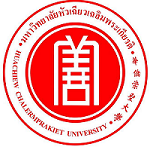Please use this identifier to cite or link to this item:
https://has.hcu.ac.th/jspui/handle/123456789/3490| Title: | ความเชื่อทางศาสนาพุทธมหายานและศาสนาเต๋าของชาวไทยเชื้อสายจีนในจังหวัดสมุทรปราการ : มุมมองจากโรงเจ |
| Other Titles: | Mahayana and Taoism Beliefs of Thai-Chinese in Samutprakarn Province : The Critical on Chinese Vegetarian Halls 北揽省华裔的大乘与道教信仰 :以北揽省斋堂为观察点 |
| Authors: | พรพรรณ จันทโรนานนท์ พัชรินรุจา จันทโรนานนท์ Pornpan Juntaronanon Patcharinruja Jantaronanont 刘丽芳 Huachiew Chalermprakiet University. College of Chinese Studies National Institute of Development Administration. School of Social Development and Management Strategy |
| Keywords: | ชาวจีน -- ไทย -- สมุทรปราการ Chinese -- Thailand -- Samut Prakan 中国人-- 泰国 -- 北榄府 โรงเจ 素食餐厅 ความเชื่อ Belief and doubt ศรัทธา (พุทธศาสนา) Faith (Buddhism) 信仰 信仰(佛教) |
| Issue Date: | 2020 |
| Publisher: | มหาวิทยาลัยหัวเฉียวเฉลิมพระเกียรติ |
| Abstract: | จังหวัดสมุทรปราการเป็นเมืองสําคัญที่ตั้งอยู่ปากน้ำเจ้าพระยา เป็นเมืองที่มีบทบาททางด้านเศรษฐกิจ มาตั้งแต่สมัยโบราณ เพราะเป็นที่จอดแวะพักขนถ่ายสินค้าของเรือที่จะเข้าไปทําการค้าในพระนครศรีอยุธยาและบางกอก เมืองนี้จึงเป็นเมืองสําคัญยิ่งและมีความเจริญตั้งแต่ก่อนที่ปากน้ำจะตั้งเป็นจังหวัดสมุทรปราการชาวจีนที่เข้ามาตั้งถิ่นฐานที่ปากน้ําในยุคเก่าทําให้ปากน้ำกลายเป็นเมืองจีนขนาดเล็กในตําบลปากน้ำ รวม 3 แห่ง ส่วนอําเภอต่างๆของจังหวัดที่เป็นชุมชนชาวจีนอาศัยอยู่ก็จะมีโรงเจหรือศาลเจ้าเป็นศูนย์กลางของชุมชน ความเชื่อทางศาสนาของชาวจีนในไทยล้วนรับมาแต่บ้านเกิดที่ตนอาศัยอยู่ก่อน เมื่ออพยพมาอยู่ในจังหวัดสมุทรปราการความเชื่อเหล่านั้นจึงปรากฏอย่างชัดเจน โดยแหล่งชุมชนชาวจีนทุกแห่งจะมีโรงเจ หรือศาลเจ้าตั้งอยู่และความเชื่อทางศาสนานั้น แม้จะเป็นความเชื่อแบบ “ซานเจี้ยว” (三教) (หมายถึงศาสนาที่เกิดขึ้นจากการรวมกันของศาสนาพุทธมหายาน ศาสนาเต๋าและศาสนาขงจื่อ) ที่เริ่มต้นมา ตั้งแต่สมัยราชวงศ์หยวนและเผยแผ่ออกสู่ดินแดนทางใต้ของจีนในสมัยต่อมาจนส่งผลต่อชาวจีนอพยพแต่โรงเจและศาลเจ้าในสมุทรปราการนั้น หากพิจารณาจากรูปเคารพแล้ว มิได้แสดงให้เห็นว่ามีความเชื่อแบบ “ซานเจี้ยว” อย่างชัดเจนเพียงอย่างเดียว เพราะบางแห่งมีการรวมความเชื่อพื้นถิ่นเข้าไปด้วยแต่การปฏิบัติด้านพิธีกรรมทางศาสนาของโรงเจและศาลเจ้า ส่วนใหญ่แสดงให้เห็นว่าเป็นความเชื่อแบบผสมผสานที่เรียกว่าแบบ “ซานเจี้ยว” คือมีการผสมปนกันระหว่างศาสนาขงจื่อพุทธศาสนามหายานกับศาสนาเต๋า แต่ยังมีโรงเจที่สร้างขึ้นจากคติความเชื่อทางศาสนาพุทธมหายานอย่างแท้จริงและศาสนาเต๋าผสมกับศาสนาพุทธมหายานบ้าง Samutprakarn is an important city situated on the delta of Chaopraya River. It was of great economic importance since ancient time because it served as a resting spot for shipsto transport their goods to sell in Ayutthaya and Bangkok. Therefore, this city was very important and highly developed even before it was made into Samutprakarn province. Many Chinese people who made Paknam their home back in the days created a total of 3 small Chinese cities in Paknam sub district. As for Chinese communities in other districts in the province, the Chinese vegetarian hall or shrine would act as the centers of the communities. Religious beliefs of Chinese people in Thailand were brought over from their homeland. When they moved to Samutprakarn, those beliefs were clearly displayed by having Chinese vegetarian halls or shrines in every community. As for their religious belief, even if it was the “San jiao”(三教)style (meaning a mixture of Buddhism, Taoism and Confucianism) which started during the Yuan dynasty and later spread to the southern region of China and thus had an effect on Chinese diaspora, the Chinese vegetarian halls and shrines in Samutprakarn did not display a clear “San jiao”style if the worship statues were taken into account , because some vegetarian halls are mixed with Thai belief .Rather, religious practices of the Chinese vegetarian halls and shrines showed that no Chinese vegetarian hall was strictly following the “San jiao”, but there are some vegetarian halls following Mahayana Buddhism and some is mixed with Taoism. |
| URI: | https://has.hcu.ac.th/jspui/handle/123456789/3490 |
| Appears in Collections: | College Of Chinese Studies - Research Reports |
Files in This Item:
| File | Description | Size | Format | |
|---|---|---|---|---|
| Mahayana-and-Taoism-Beliefs-of-Thai-Chinese-in-Samutprakarn-Province.pdf | 10.13 MB | Adobe PDF | View/Open |
Items in DSpace are protected by copyright, with all rights reserved, unless otherwise indicated.
